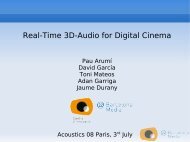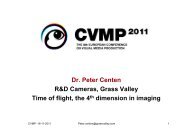Shadow Multiplexing for Real-Time Silhouette ... - EDM - UHasselt
Shadow Multiplexing for Real-Time Silhouette ... - EDM - UHasselt
Shadow Multiplexing for Real-Time Silhouette ... - EDM - UHasselt
You also want an ePaper? Increase the reach of your titles
YUMPU automatically turns print PDFs into web optimized ePapers that Google loves.
LLL0 I 0 I 0(a) Red (b) Green (c) BlueFigure 3. Relationship between the luminance and current of a (a)red, (b) green and (c) blue LED. Notice the strong green responseof the CCD camera <strong>for</strong> the blue LED.I4.2. CalibrationIn order to provide our algorithm with the light propertiesof the setup and the relative positions of the hardwarecomponents, we will now cover radiometric and geometriccalibration.4.2.1 RadiometricEach LED is connected to a controllable power source. Byadjusting the current sent through the LED, more light willbe emitted. As can be seen in Figure 3, the luminance willnot respond linearly in function of the current. This plot canbe measured or found in the characteristics provided by theLED manufacturer. In practice this means that the currentrequired <strong>for</strong> getting a certain intensity value can simply befound in a lookup table containing the LED characteristics.4.2.2 GeometricThe geometric calibration of the setup consist of scanningthe 3D structure of the diffuser and defining the locationof each point light source. We assumed that our diffuseris planar, simplifying the calibration. We calibrate it by attachinga checkerboard pattern and using a standard calibrationmethod [3, 10]. More in general all kinds of 3D scanningtechniques, such as structured light [23] can be used<strong>for</strong> scanning the diffuser.Finding the location of each light is achieved using thecalibration proposed by Yamazaki et al. [27]. It analyzesthe ellipsoidal shadows cast from occluding spheres.5. ResultsIn this section we will show results we obtained and theproblems we encountered. We will also demonstrate twoapplications where the extracted silhouettes are used.In figure 7 we show a couple of extracted silhouettes.Here<strong>for</strong>e we use two red, two green and two blue LEDs withdifferent intensity. These results indicate that this techniqueis suitable <strong>for</strong> different types of materials like low albedo orspecular surfaces.(a) Demultiplexed shadow(b) PostprocessingFigure 4. Captured images contain soft shadows: (a) Straight <strong>for</strong>wardshadow demultiplexing method (b) Figure (a) after per<strong>for</strong>mingerosion and dilation5.1. ProblemsThe straight<strong>for</strong>ward method <strong>for</strong> demultiplexing cansometimes introduce some errors and artefacts which weshow can be reduced.5.1.1 Soft BordersA point on the diffuser does not only receive light fromeach light source, but also from the neighbouring illuminatedpoints. The diffusion due to scattering within the diffuserresults in a smoothened transition at the borders ofthe shadows. These soft borders sometimes create a ghostsilhouette as shown on Figure 4(a). Most of the time theyhave a size of only a few pixels. There<strong>for</strong>e they can easilybe removed by per<strong>for</strong>ming morphological operations suchas erosion and dilation as shown on Figure 4(b).Soft borders can also occur due to motion blur. We canminimize these by lowering the shutter time of our camera.There<strong>for</strong>e we require brighter LEDs. LED strobing isa common method <strong>for</strong> obtaining the same intensity with alower shutter time reducing motion blur. However, the OS-RAM Diamond Dragon LEDs do not allow significant extralight output in pulse operation, so this technique will requirea different selection of LEDs.5.1.2 Camera noise<strong>Shadow</strong> demultiplexing is a local algorithm meaning thatcamera noise can result in faulty results at some pixels.Even though this noise is already minimal, it will even befurther reduced by the erosion operation.5.1.3 Object MaterialOur method works well <strong>for</strong> sufficiently opaque materialssuch as high and low albedo diffusers, glossy and specularsurfaces, and many translucent materials. However, as isthe case <strong>for</strong> standard background subtraction, this method





